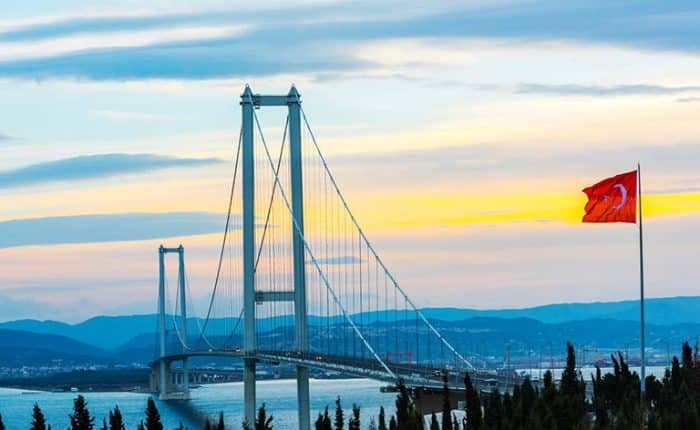The Bosphorus Strait has been around for way longer than Istanbul. Experts believe that it was once a river valley, but as the tertiary period ended, the valley was drowned by the sea. In ancient texts, writers refer to the Bosphorus as the Thracian Bosporus to distinguish it from the strait of Kerch (the Cimmerian Bosporus).
The Bosphorus was also instrumental to Byzantium’s development, once a small town sitting at the strait’s southern entrance (where the waterway empties into the Sea of Marmara). Thanks to this strategic location, the small village was chosen as the seat of the Eastern Roman Empire, and the rest is history; it became Constantinople. In 1453 the city was conquered by the Ottoman Empire. The Ottoman Turks constructed a fortification on each side of the strait, Anadoluhisari (1393) on the Asian shore and Rumelihisari (1451) on the European coast.
In the 20th century, after the end of WWI, the League of Nations took over ownership of the strait for a short while before it was handed back to Turkey.
Today, three iconic bridges run from the Asian side to the European side of Istanbul. The oldest is the Bogazici (Bosphorus) bridge, whose construction started in 1970 and ended in 1973. This bridge was officially opened on October 29th, 1973, exactly 50 years after Turkey was declared a republic.
It is the southernmost bridge in the strait and stretches for 1074 meters between the Beylerbeyi neighborhood in Asia and the Ortakoy neighborhood in Europe. In July 2016, the Bosphorus bridge was renamed the “Martyrs of July 15th” in honor of the victims who died during the failed attempt to overthrow the Turkish Government on July 15th, 2016.
The second bridge was opened in July 1988, called the Fatih Sultan Mehmet Bridge. It stretches for 1090 meters between Anadolu Hisari and Rumeli Hisari neighborhoods. Finally, the third bridge was opened in 2016, and it sits at the northernmost entrance of the Black Sea. It stretches for 1408 meters between the Garipce and Poyrazkoy villages on European and Asian sides.
The name Bosphorus comes from two Greek words; bous (meaning cow) and poros (crossing place), which come from a Greek legend involving the god Zeus, his wife Hera, and his extramarital affair, the Greek girl Io. When Hera discovered the affair, Zeus turned her into a cow to protect her from his wife’s wrath. He then created a horsefly to sting her, which made Io swim across the strait hence the name. Hera then created and sent a gadfly that tormented Io, which made her wander over the earth until she came to the Eastern shores of Bosphorus and swam across to safety. Once the girl had crossed the Bosphorus, she was restored to her original form and gave birth to Epaphus.



Cruising the Bosphorus is one of Istanbul’s most breathtaking experiences, yet it is massively underrated. Therefore, many people who visit Istanbul finish their tour without ever undertaking the cruise. But for those who do, it is a memorable experience worth every minute.
Most cruises start at the southern entrance near the strait’s most iconic landmark, the Maiden’s Tower. The tower has a long and rich history, and if your tour package allows it, you may get to visit and sip a cup of coffee at the tower’s summit, from where you will get a stunning view of the golden horn and the strait before you.
The cruise goes upstream, taking you through the heart of the city and revealing Istanbul’s hidden treasures. The shores are lined with lavish ancient palaces, villages, ruins, breathtaking mosques, and gardens on the European and Asian sides. Some of the cruise’s best sights include Topkapi Palace, Dolmabahce Palace, Ciragan Palace, Selimiye Barracks, Yildiz Park, and Palace. You will also see Istanbul’s stunning skyline decorated with some of its most iconic minarets from the ferry’s top.
While enjoying your scenic cruise, don’t forget to look at the shimmering blue waters below. This is because dolphins tend to pop up once in a while and accompany sailors on their journey upstream. These dolphins usually swim from the Sea of Marmara to the Black Sea and are loved and treasured by Istanbul. There are mainly three species in the strait; the common dolphins, harbor porpoises, and the bottlenose dolphins. Luckily, dolphins are an all-year-round feature in the Bosphorus, so you are likely to see them regardless of the time of the year you visit.
A basic ferry cruise along the Bosphorus usually costs around 25TL per person, with children under 12 charged 10TL. Depending on the year and trip, private yachts will cost a group anywhere between 299 Euros and 499 Euros.
Some excellent attractions near the Bosphorus include the Spice Market, Galata Tower, Dolmabahce Palace, and maybe a Turkish coffee break at the Maiden’s Tower sunset. Therefore, remember to include these during your cruise day.